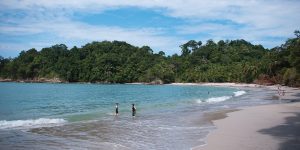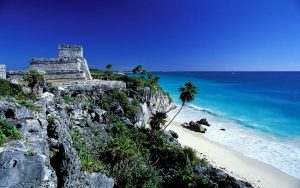Day 1 Santa Cruz Isl./Galapagos Islands
Very early this morning you will be transferred to the airport for your flight to Galapagos.
There are two types of landings throughout your Galapagos tour:
Dry landing: guests step from the dinghy onto rocks or a dock.
Wet landing: as the dinghy edges onto a sandy beach, guests step into knee-deep water and wade ashore.
Please remember that the exact route and program may vary according to weather and ocean conditions and the wildlife we encounter.
Morning arrival to Baltra Island by plane and immediate transfer to the dock to board your cruise. Welcome introductory briefing and lunch.
PM: Bachas Beach (Santa Cruz)- Head to Bachas Beach where the sand is made of decomposed coral, making it soft and white, and a favourite site for nesting sea turtles. Spot abundant Sally Light-foot crabs on the lava rocks along the water’s edge — these crabs will eat anything they can get their claws on! Trek to see a wide range of wildlife, including flamingos, hermit crabs, black-necked stilts, and sea lions.
Day 2 Isabela Isl./Galapagos Islands
AM: Tagus Cove is located on the Northwestern coast of Isabela Island. It is a historical site visited by Charles Darwin in 1835, where graffiti has been carved into the rock walls by visitors over the past centuries. This spot has been frequented by whalers and pirates since the 1800’s that used the area as anchorage. The site’s name dates to 1814 when it was visited by a British ship, The Tagus, which had anchored there in search of giant tortoises to be used as food supply on the boat.
Here, admire a variety of seabirds, such as blue-footed booby, brown noddy, terns, flightless cormorant, and Galapagos penguins depending on the season. Occasionally you might see woodpecker finches, the Galapagos hawk, the yellow warbler, or a large-billed flycatcher.
After a dry landing, climb up the trail to visit Darwin’s Lake. The lake is located on the slopes of Darwin Volcano and is, surprisingly, a saltwater lake above sea level. Your naturalist guide will tell you what the different scientific theories for this occurrence are. Meanwhile, while snorkelling, there are chances to see sharks, turtles, and sea stars. You may also see various types of colourful fish.
PM: Urbina Bay – is a fascinating visitor site that came to be as the shallow sea bottom uplifted in 1954 showing a large coral reef sticking up above sea level. Because of this, Urbina Bay is one of the newest features in the Galapagos. This visitor site is located west of Isabela and provides spectacular views of the Alcedo volcano. The long trail starts on the beach where a wet landing is made. In this location, you will likely see wild Galapagos Giant Tortoises and Galapagos Land Iguanas. As the trail circles back towards the shoreline, you’ll come across colonies of the unique Galapagos Flightless Cormorant which lost its ability to fly. This is also a great spot for snorkelling, as you can come close to a Galapagos Penguin Colony and see Galapagos Marine Iguanas feeding underwater.
Day 3 Fernandina Isl./Galapagos Islands
AM: Espinosa Point – is one of the most pristine islands in the world, with none of man’s introduced species to date. From here we can see the island of Isabela across the Bolivar Channel, an area that boasts some of the highest diversity of endemic sea fauna in the Galapagos. Fernandina is the youngest of the Galapagos Islands and a visitor favourite. When landing, check out the tidal pools where sea life is abundant, including small fish and molluscs. If we are lucky, a sea turtle or ray may be trapped in the pools. A little further ahead we will pass through some marine iguana burrows and sea lion colonies. The trail continues to where several flightless cormorants have their nests. This remarkable bird is only found in the western Galapagos, and experts estimate that there may only be a few hundred individuals in total.
PM: Vicente Roca Point – has great deep-water snorkelling at one of the richest marine havens on Earth (Bolivar Channel). Vicente Roca Point is renowned for its Galápagos green turtles, which are very numerous on the bay. Although the spot is known for its high concentration of green turtles, sharks, and rays can also be observed when underwater visibility is good. We take a dinghy ride along the coast to observe the great diversity of sea and coastal birds such as Nazca and blue-footed boobies, noddies, brown pelicans, penguins, flightless cormorants. The upwelling of cold-water currents in this part of the Galapagos gives rise to an abundance of marine life. Our snorkelling will take us along the cliffs and offer the chance to explore two shallow underwater caves with rich marine wildlife.
Day 4 Santiago Isl./Galapagos Islands
AM:Puerto Egas – Explore the spectacular shoreline of Puerto Egas, also known as James Bay. Spot a great number of shore birds and reptiles – the beach area is home to a plethora of wildlife. Grab a snorkel and jump into the water right off the beach to explore Puerto Egas’ interesting underwater world. Keep your eyes peeled for rays, turtles, and reef sharks while snorkelling. After, visit the large tidal pool area – marine iguanas and Sally Light-foot crabs are everywhere.
PM: Playa Espumilla & Buccaneer Cove – Head to Playa Espumilla, one of the most idyllic beaches in the Galápagos Islands, which has thick mangroves and sea turtle nesting sites. Jump into the panga and cruise alongside high cliffs and rock formations on this visit to Buccaneer Cove, which was a favourite hideout for pirates looking to stock up their boats with food and water. Spot sea lions relaxing on the beach and sea birds nesting in the cove – there’s lots to see at this site.
Day 5 Depart Santa Cruz Isl.
AM: North Seymour – have an amazing wildlife experience visiting North Seymour Island – this island is teeming with life! Follow trails to see all the action (you may need to give way to a passing sea lion or marine iguana while walking). See blue-footed booby nests where mating pairs perform their courtship dance. Head to a rocky shore to see flocks of pelicans having lunch in a dive bomb-feeding frenzy, then turn inland to a large nesting site of magnificent frigate birds. These huge, dark acrobats have two-metre (6.5 ft) wingspans, and males, with their puffed-up scarlet throat sacks, sit precariously perched in low bushes to watch over their equally large chicks. Top off the excursion with a snorkel among sea lions and rays. Then, transfer back to Baltra for your return flight to mainland.




















































